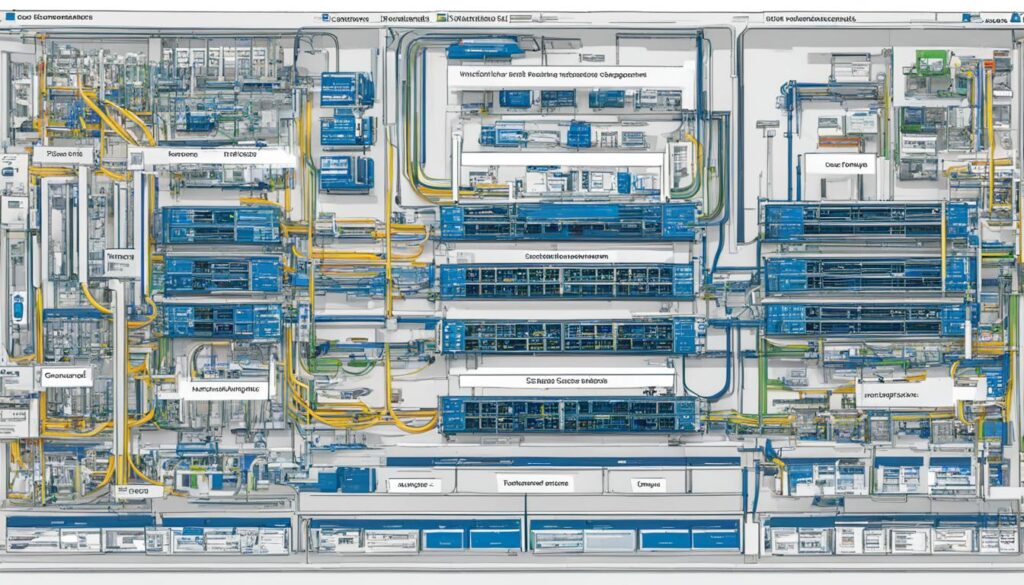Welcome to our article on SystemVerilog testbench architecture. In this section, we will explore the significance of this architecture in improving verification skills and design efficiency. As verification engineers, it is crucial to understand the importance of a well-structured testbench to ensure accurate and efficient verification processes.
By implementing SystemVerilog testbench architecture, engineers can gain a deeper understanding of the design under test and its behavior. This architecture allows for comprehensive verification of complex designs, helping to identify bugs, errors, and performance issues at an early stage.
Verification skills play a vital role in ensuring the reliability and quality of the design. With a solid grasp of SystemVerilog testbench architecture principles, engineers can enhance their verification skills, enabling them to effectively verify intricate designs and meet project requirements.
Design efficiency is another crucial aspect that can be achieved through the utilization of a well-structured testbench. By implementing best practices in testbench architecture, engineers can save time and resources by creating reusable and scalable components. This leads to efficient verification processes and ultimately improves the overall design development cycle.
As we delve deeper into the various components, organization, and optimization techniques associated with SystemVerilog testbench architecture, we aim to provide you with valuable insights and practical knowledge. Understanding and implementing a robust testbench architecture is key to maximizing verification skills and ensuring design efficiency.
Table of Contents
Understanding Testbench Components and Organization
In this section, we will delve into the various components and organization of a testbench in SystemVerilog. Understanding these essential elements is crucial to building an efficient and effective verification environment.
1. Testbench Components
A SystemVerilog testbench consists of several components that work together to stimulate and monitor the design under test (DUT). These components include:
- 1.1 Testbench Top
- 1.2 Testbench Environment
- 1.3 Testbench Agents
- 1.4 Testbench Stimulus
- 1.5 Scoreboard
- 1.6 Coverage Collector
Let’s explore the purpose and functionality of each component:
| Testbench Component | Purpose | Functionality |
|---|---|---|
| Testbench Top | Serves as the top-level module | Instantiates and connects the testbench components |
| Testbench Environment | Creates the testbench environment | Provides the necessary resources for the verification process |
| Testbench Agents | Handle the interfacing between the DUT and the testbench | Drive stimulus to the DUT and collect response |
| Testbench Stimulus | Generates stimuli for the DUT | Applies input sequences and stimuli to the DUT |
| Scoreboard | Checks the correctness of the DUT’s outputs | Compares the DUT’s output with the expected results |
| Coverage Collector | Collects functional and code coverage information | Collects data on which parts of the design have been exercised during simulation |
2. Testbench Organization
Organizing a testbench in a structured and modular manner promotes reusability, maintainability, and scalability. The following principles can guide the organization of a SystemVerilog testbench:
- 2.1 Hierarchy
- 2.2 Decoupling
- 2.3 Configuration
- 2.4 Interfaces
Let’s understand each principle in detail:
2.1 Hierarchy
Hierarchy refers to dividing the testbench into different levels and modules, each responsible for a specific functionality. This allows for easier management and enables reusability of individual modules.
2.2 Decoupling
Decoupling involves separating the testbench components from each other and from the DUT. This minimizes dependencies and allows independent development, testing, and modification of individual components.
2.3 Configuration
Configuration enables the flexibility of the testbench by allowing different configurations for different test scenarios. It allows easy switching of parameters, test data, and test sequences, enabling thorough verification of the DUT.
2.4 Interfaces
Interfaces play a crucial role in connecting the various testbench components and the DUT. Well-defined interfaces enhance the reusability and modularity of the testbench, making it easier to integrate different components and adapt to changes in the DUT.
By following these principles, we can achieve a well-organized and structured testbench that promotes collaboration, efficiency, and scalability.
In the next section, we will discuss the building of a modular and scalable testbench infrastructure using SystemVerilog, focusing on the benefits and best practices to maximize verification productivity.
Building a Modular and Scalable Testbench Infrastructure
In this section, we will delve into the process of building a modular and scalable testbench infrastructure using SystemVerilog. A modular testbench contributes to better organization, maintainability, and reusability, while a scalable infrastructure enables efficient verification of increasingly complex designs.
Modularity allows us to break down the testbench into smaller, self-contained units called modules that can be developed independently and easily integrated into the overall testbench architecture. Each module focuses on a specific functionality, making it easier to debug and update without affecting other components.
When designing a modular testbench, it is essential to identify the common elements and functionalities that can be reused across multiple testbenches. By utilizing reusable modules, we can significantly reduce development time, enhance productivity, and improve the overall quality of the testbench.

Benefits of Modular Testbench
A modular testbench offers several benefits:
- Easy maintenance and debugging: With a modular approach, it is simpler to locate and fix issues as each module is isolated and can be tested individually.
- Enhanced reusability: Reusable modules can be easily integrated into different testbenches, allowing us to leverage existing functionality and save development time.
- Scalability: As the design complexity increases, a modular testbench can be expanded by adding or modifying modules without affecting the entire testbench.
Best Practices for Implementing a Modular Testbench
To ensure the effectiveness of a modular testbench, we should follow certain best practices:
- Clearly define module interfaces: Clearly defined interfaces between modules facilitate seamless integration and communication.
- Encapsulate functionality: Each module should encapsulate a specific functionality, making it self-contained and independent.
- Maximize code reuse: Identify common functionalities and create reusable modules that can be shared across various testbenches.
- Ensure flexibility: Design modules to be easily configurable, allowing for parameterization and customization.
- Use industry-standard interfaces: Utilize industry-standard interfaces, such as the Universal Verification Methodology (UVM), to enhance compatibility and interoperability.
By adhering to these best practices, we can create a robust and efficient modular testbench infrastructure that not only improves verification productivity but also facilitates future enhancements and scalability.
Comparison of Modular and Non-Modular Testbench Architecture
| Aspect | Modular Testbench | Non-Modular Testbench |
|---|---|---|
| Organization | Well-structured with separate modules for different functionalities | Monolithic structure with minimal separation of functionalities |
| Maintenance | Easy to maintain and debug due to isolated modules | Difficult to locate and fix issues due to interdependencies |
| Reusability | High reusability of modules across multiple testbenches, reducing development time | Limited reusability, leading to redundant code and increased development effort |
| Scalability | Can be scaled by adding or modifying modules without affecting the entire testbench | Challenging to scale and accommodate complex design changes |
Implementing a modular and scalable testbench infrastructure in SystemVerilog provides numerous advantages, including easier maintenance, enhanced reusability, and improved scalability. By breaking down the testbench into modular components and following best practices, we can create a flexible and efficient verification environment that supports the verification of complex designs.
Advanced Techniques for SystemVerilog Testbench Optimization
In this section, we will explore advanced techniques and strategies for optimizing SystemVerilog testbenches. By implementing these techniques, you can improve simulation speed, reduce memory usage, and enhance overall performance, leading to more efficient verification.
1. Utilize Testbench Simulators
Testbench simulators play a critical role in optimizing the performance of your SystemVerilog testbench. Familiarize yourself with the features and capabilities of popular simulators such as VCS, QuestaSim, and ModelSim. Take advantage of their optimization options, such as compile-time and runtime optimization flags, to maximize the efficiency of your testbench.
2. Use Appropriate Data Types
Choosing the right data types can significantly impact the performance of your testbench. Use the smallest data types that accurately represent your variables to minimize memory consumption. For example, if a variable only requires a range of values within 0-255, use a byte-sized data type instead of a larger integer type.
3. Implement Constrained Randomization
Constrained randomization is a powerful technique for generating realistic and diverse test stimuli. By specifying constraints on data variables, you can create a more comprehensive set of test scenarios while reducing redundant test cases. This optimization technique improves simulation speed and reduces memory usage, ensuring faster verification cycles.
4. Employ Intelligent Coverage Models
Coverage models help ensure that you thoroughly test all aspects of your design. Instead of relying solely on brute-force techniques that generate unnecessary test cases, use intelligent coverage models. These models intelligently select test vectors based on coverage holes, allowing you to focus on the untested areas of your design and optimize your testbench’s efficiency.

5. Optimize I/O Communication
Efficient communication between the testbench and the design under test (DUT) is essential for a fast and robust verification process. Optimize your I/O communication mechanisms by leveraging high-level verification languages and message passing interfaces like DPI-C and UVM’s Transaction Level Modeling (TLM). These techniques can minimize the overhead associated with communication and improve the overall performance of your testbench.
6. Implement Hierarchical Testbenches
Developing hierarchical testbenches allows you to separate the verification environment into reusable and modular components, enabling efficient verification across multiple levels of design hierarchy. This approach reduces redundancy and enhances scalability, making it easier to debug, maintain, and extend your testbench as your project evolves.
7. Leverage Assertions and Functional Coverage
Assertions and functional coverage are important tools for ensuring the correctness and completeness of your design verification. Carefully design and implement assertions to catch errors early in the verification process. Use functional coverage to measure the progress of your verification efforts and identify coverage gaps. These techniques help optimize your testbench by efficiently identifying and resolving design issues.
8. Profile and Optimize Performance
To identify bottlenecks and areas for improvement, profile the performance of your testbench using tools like SystemVerilog Profilers and Code Coverage Analyzers. Analyze the results to identify sections of the testbench that consume excessive time or memory. By optimizing these critical areas, you can further enhance the efficiency and effectiveness of your testbench.
By employing these advanced techniques for SystemVerilog testbench optimization, you can achieve faster verification cycles, reduced memory usage, and improved overall performance. Incorporate these strategies into your testbench development process to enhance your verification skills and design efficiency.
Conclusion
In conclusion, our exploration of SystemVerilog testbench architecture has revealed its significant role in enhancing verification skills and design efficiency. We have seen how understanding and implementing a well-structured testbench architecture can greatly contribute to the success of a verification process.
By comprehending the various components and organization of a testbench, engineers can effectively utilize their functionality and achieve efficient verification. Building a modular and scalable testbench infrastructure further enhances the flexibility and reusability of the testbench, enabling seamless integration with different designs and enabling efficient verification across multiple projects.
Moreover, through the application of advanced techniques for testbench optimization, engineers can enhance simulation speed, reduce memory usage, and improve overall performance. These optimizations not only save valuable time and resources but also contribute to the successful completion of complex verification tasks.
In conclusion, it is crucial for engineers to invest the time and effort into understanding and implementing a well-structured SystemVerilog testbench architecture. By doing so, they will not only enhance their verification skills but also improve design efficiency, ultimately leading to more reliable and successful designs.

